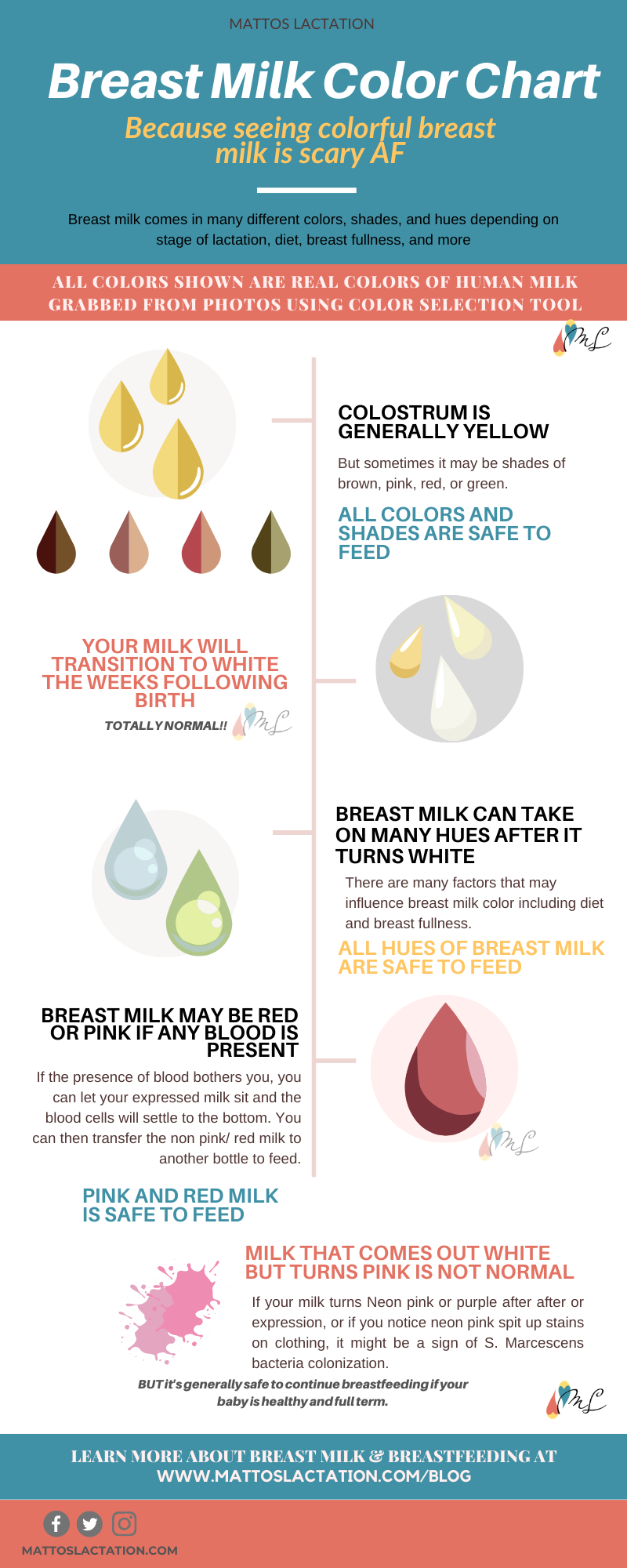Why is my breast milk green, blue, or pink? | Milk Color Chart
Read time | 6 minutes
Most people think of milk as white.
If you’re very knowledgeable about human milk or breastfeeding, you may think of milk being white or yellow, because colostrum is both yellow & actual milk.
I would bet that nobody would consider milk to be shades of green, blue, browns, or reds, and if they saw human milk of those colors, they would undoubtedly think it unsafe to give their baby
.
In reality, ALL colors of milk are safe to give but sometimes it takes knowing why milk is the color that it is to feel reassured about feeding it to your baby.
I’ve made this handy infographic that shows the actual colors of human milk and below will detail what causes each color.
Milk Colors
Yellow
Colostrum is typically described as being yellow & thick compared to white, thin mature milk. Colostrum comes in many different shades of yellow, from deep gold to a bright yellow-orange.
Beta Carotene is responsible for colostrum’s yellow color, and the high ratio of Beta Carotene to other milk components provides many benefits to a newborn the first few days after delivery. Being that it’s an antioxidant, Beta Carotene protects your newborn from oxidative stress by preventing free radicals from causing organ damage.
Essentially, Colostrum’s color is just the outward sign of one aspect of its hard work in protecting your baby.
After milk transitions to white, some parents notice at times their milk is a bit yellow while other parents may always have a yellow tint, never seeing “pearly white” milk.
Eating a diet rich in foods containing Beta Carotene is the most likely cause for yellowish mature milk.
Because most people don’t eat a diet with adequate Beta Carotene, you should be proud if your milk is always a bit yellowish!
Milk may turn yellow during or after an illness. This switch in color is again an outward sign of your milk’s hard work of protecting your baby, as the milk changes to yellow due to an increase in immunoglobulins, white blood cells, and leukocytes. These are the type of cells that help fight off illness.
As you might imagine, yellow breast milk is always safe to feed your baby.
Clear
Sometimes colostrum is not distinctly yellow, but rather transparent and watery. This is a normal variation and is nothing to be concerned about.
Green
Colostrum: Another variation to normal colostrum includes shades of green.
Mature milk: Mature milk may have a green tint to it or be very green, and neither is a sign of an issue. Sometimes a diet rich in leafy green vegetables will result in greenish tinted milk, and other times it’s a normal variation.
Note: A thick, green sticky substance that leaks or can be expressed from the breast may be a sign of duct ectasia. Though it’s a benign condition, if you randomly develop green discharge, please make an appointment with your care provider.
Blue
Shades of blue milk are entirely normal and probably the most common color I see discussed.
Because of how many breastfeeding parents use a breast pump or express their milk, more people are being exposed to the wide array of breast milk colors.
I think blue milk might be most concerning to parents who worry about if their breast milk is fatty enough and whether or not they have a “foremilk/hindmilk imbalance. ” They see blue, “watery” milk and immediately suspect an issue with their milk quality.
I address the “foremilk” and “hindmilk” conceptions in another blog post, but I do think it’s worth clarifying a bit here-
When breasts are full, milk will tend to run on the blue side and may become more white and creamy at the end of the feed.
Though people tend to attribute the bluish milk to “foremilk”, it’s not a different or distinct type of milk compared to the “hindmilk”.
We notice bluish milk with full breasts and long times between expression sessions because as time passes, more water is drawn into the milk, increasing breast pressure. When you have the first few letdowns, due to the forces in the breast and the densities (so to speak) of the various milk components, more of the aqueous or “watery” parts of the milk flow out first.
As the breast continues to drain more of the thicker components, such as fat, get released, and by the time the whole breast is empty, everything is combined.
To be clear- the bluish watery milk and white creamier milk have the same components and are the same milk. There are not two different types. It’s just the ratio of the various components change.
Parents who feed their baby’s frequently or drain their breasts completely and often tend to have thicker milk. Parents with an exceptionally high rate of milk production or those who go long stretches between feeds tend to have a more bluish hue to their milk.
Regardless of how white or blue your milk is, it is safe to feed your baby.
Red/pink
Bright red or pink milk is concerning to parents, especially when they have no idea what caused it.
Any injury to the nipple or breast tissue (such as a burst capillary) can cause bleeding, with the latter generally causing darker red milk.
A little bit of blood can turn a whole bottle red, and many parents are alarmed when they see they “pumped a whole bottle of blood”. As such, many parents choose to avoid feeding blood milk to their babies.
Pink or red milk is safe to feed, though some babies may refuse to drink blood-tinged milk or they may vomit after eating.
Because not everyone can afford to throw out milk, one strategy many parents use is to let the bottle sit in the fridge for a couple of hours to allow the blood cells to settle to the bottom of the bottle. Because the blood cells are denser, they will stay at the bottom allowing you to pour off the “clean” milk, which you can feed or mix with freshly expressed milk.
Brown
Brown or brownish-red milk, a phenomenon called “Rusty Pipe Syndrome” is not uncommon soon after delivery. These colors are due to a small amount of blood in the colostrum and the milk is safe to feed. Generally, after a couple of feeds or a couple of days, the brownish-red color will go away.
Black
Black milk has been reported with use of a medication called Minocycline, a medication considered safe for short term use in lactating parents.
Breast milk may also appear black, rather than brown or red if there is blood present.
Neon pink/purple
Milk that transitions from white to neon pink/purple may be a sign of Serratia Marcescens colonization. I’ve written about this at length which you can read about here.
Even during an S. Marcescens colonization, breast feeding is encouraged for full term healthy babies.
You may also like











